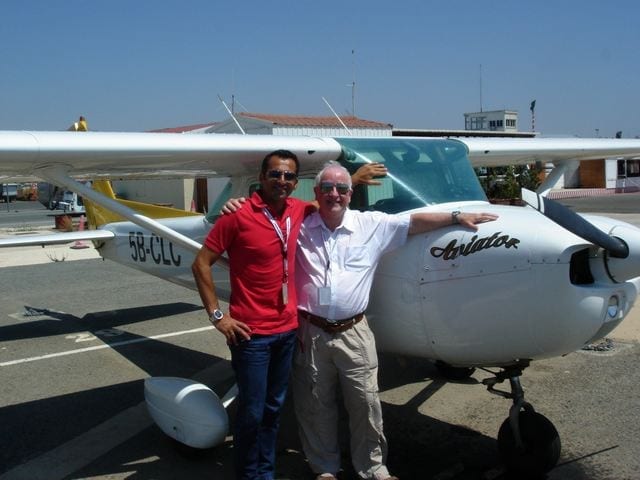It was the summer of 1962 and I was five years old. The red and white Piper Pacer was taxiing towards the runway of the small Bruino airport, a few miles from Turin, in the northwest of Italy, close to the Alps (don’t look for this airfield: it doesn’t exist anymore). The plane was taxiing and I was on board, filled with expectation for my first flight. I was seated in the rear bench, my father in front of me, at the side of the pilot, Mom at my left. I had a limited view in the front, but I was able to look out from the side window.
The little plane took off for a short, scenic tour and I was fascinated by the thrill of flying, by the view and most of all by the pilot. I spent most of the time looking at him, trying to understand what he was doing and the purpose of those strange gauges and features. Like the handle over his head he was cranking occasionally.
In the summer of 2008 I was looking at the pictures on an aviation site on the internet when my attention was captured by the photo of a red and white PA-20 and by the registration marks: I-CERR. I knew that back in the 1960s, Bruino airfield was owned by the Cerrina family. Was it possible that it was the plane of my first flight? I wasn’t even sure about the model. I’d been told by Dad it was a Piper, but it was common (and it’s still common today in Italy) to call every light plane a “Piper.”
Decades later, I was able to remember some details. The plane was high wing, taildragger and with the trim crank on the top of the cockpit. Just like the Piper PA-20 Pacer.
I sent an e-mail and after a couple of days I got phone call from a gentleman named Giorgio Zecca, owner of Aero Eli Servizi, a helicopter company based in L’Aquila, two hours’ drive from Rome, and owner of India Charlie Echo Romeo Romeo. He confirmed that the old Pacer was property of the Cerrina family and based in Bruino in the early 60s. The only Piper Pacer they had, the only PA-20 registered in Italy. Bingo! He also said to me, “Why don’t you come here? I’ll let you fly the plane.”
After a few days I was on an airliner headed to Rome Leonardo da Vinci Airport, a 50-minute flight, followed by a rented Fiat across the Apennines to Preturo airfield in L’Aquila.
Giorgio Zecca was waiting for me in his office with his son Davide, also an airplane and helicopter pilot. On his desk was an old aircraft airworthiness certificate of a Piper PA-20 registered I-CERR.
“India Romeo Romeo,” Giorgio Zecca told me, “was built in 1952. She arrived in Italy in 1961 and the first Italian owner was the Cerrina flying school on the Bruino airfield. The plane was used for a few years for instruction and recreational flights, then was sold to the Sassari Aero Club, in Sardinia. After that, the Pacer had many owners, the last one being an Alitalia captain. When he died, the plane was abandoned. When we bought her, the airworthiness certificate was expired and the aircraft needed a total restoration.”
Giorgio and Davide Zecca, father and son, did a great job rebuilding I-CERR. They wanted to keep her as original as possible. Giorgio said, “The rugs were ruined, but we could find similar carpets made in the 50s in a warehouse. Wheel pants were missing; we bought a pair in Oshkosh, during AirVenture, and we brought ’em to Italy with us as hand baggage among the unbelieving looks of the other passengers.”
A close look at the plane, parked in front of Aero Eli Servizi’s hangar, and I had the strong feeling that she actually was the one of my first ride in the air when I was a child. I could remember a few details, like the access to the rear seats from the left door. Only one strange sensation: in my memory, the little Piper was much bigger.
I climbed in the Pacer following Giorgio. Door closed, I fastened my lap belt (no shoulder straps here), while he started the 135-hp Lycoming O-290 engine. Ready to go. We reached the runway 18 holding point; a short pause to check magnetos, then we lined up and started our takeoff run. A few minutes in the air and Giorgio said to me, “Your plane.” Hands on the yoke, feet on the rudder pedals, to keep her straight I had to push a little bit on the yoke. Giorgio pointed to the crank above me: a few turns (not fast as the button on the stick I’m used to) and the Piper was flying easily. Straight as an arrow.
Seated on the right in the narrow cockpit, close to the panel with old-fashioned gauges, a vintage radio and an outdated transponder, I could barely see the main instruments. A minor drawback if you’re flying on a beautiful sunny day and you can feel the plane with your butt. A quick glance and I saw an indicated airspeed of something between 95 and 100 knots. Not bad, for an old lady.
Making a few turns I felt the ailerons which were a little heavy, but the plane was stable and easy to fly. That’s what I remember today, after almost ten years. Most of all I remember the pride I felt because I had been able to keep the promise I had made to myself when I was five: “One day I’ll learn to fly an airplane like this.” That was a big challenge to a kid.
Time passed quickly, and it was time to land. On short final I gave back the controls to the owner. I-CERR landed with a little jolt. We cleared the runway and taxied in front of the hangar. Mixture closed, the engine stopped. Silence. My mind was full of thoughts. I had to say something, but the only words that came out of my mouth were “Thank you.”
One sad note: Giorgio Zecca passed away a few months ago. His son Davide now runs the helicopter business. I don’t know if he still flies India Romeo Romeo.
- Reuniting with a special airplane, 46 years later - January 8, 2018















Good looking plane, great that it still flies 50+ years later. Wheel pants make all the difference.. thanks for the story.
Giancarlo,
That was such a pleasure reading about your reacquaintance with the little Piper Pa-20. I have fond memories of a PA-22 owned by an uncle and used for a small flight school on our family dairy farm back in the 50’s. Also, a good friend of mine had a beautiful creame with red accents PA-20. The PA-20 to me is a far better looking aircraft. Thank you for sharing your story.
After that flight – it was ten years ago – I started falling in love with old planes. Every kind of plane: light aircrafts, old liners and warbirds. Yes, warbirds are a great way to fly.
Talking about vintage light planes, they have a lot of charm. Just like classic cars. But with a big difference, a huge one: sports cars from the 50s or the 60s are beautiful, but outdated. Affected by poor brakes, poor handling, low comfort etc. They can’t stand comparison with modern cars. Airplanes are different. Old models can fly as well as new ones. Performances can be slightly improved, but not so much. And an old short wing Piper is a great plane to fly today as it was more than 60 years ago.
GianCarlo, my first lightvairolane flight was in a lightgreen/pawn green 1954 Piper PA-22 Tri-Pacer. Dad, a career corporate pilot, flying a Twin Beech D-18s for Doubleday out of LaGuardia, borrowed the littlev plane fr. a friend, to fly us down here to Phila, Miss for an October vacation. Got airsick in the little plane, after hitting rough air over Maryland. Pukedcall over the back seat…smell of 87oct Avgas thru wingroots didbt help. It was,1955, I was 6 yrs,old…Still recall most of that little airplane flight. It also had the 135hp Lyconing 0-290 4cyl opposed engine, Sensenich prop. Became a pilot in 1982, while living in Tucson. Not current as of present. Too exoensive. Never Will forget that cool, unique, stubby, slow Tri-Pacer! Wish I could fly in one again!!